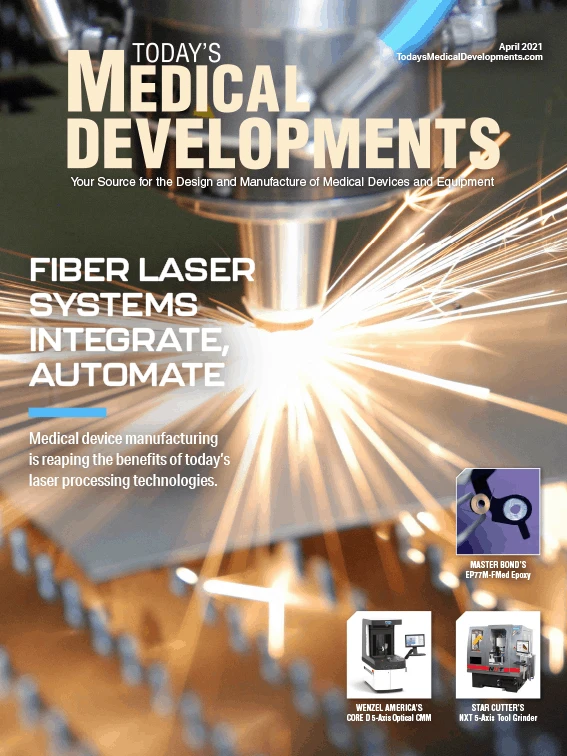

Laser systems have been important to the medical device industry since they were first commercialized in the 1970s. As laser technologies have evolved, they have enabled improved medical product designs. There have been several new laser technologies adopted in recent years, including ultra-short-pulsed lasers that impart negligible heat into medical device workpieces. Also, vision systems, such as smart cameras and their software, are now widely integrated into laser systems to verify a perfect product.
Laser materials processing systems produce devices for life-saving cardiac rhythm management, neuromodulation, orthopedics, and hearing implants. While these are more common applications of laser processing systems, the application base is expanding rapidly with new products centered around the availability of laser machine systems.
Cardiology
Pacemakers contain heat-sensitive electronics, which is one reason laser systems are used to manufacture them – net heat transfer is manageable with appropriately engineered laser systems.
Producing cardiac rhythm management devices requires several industrial laser processes. Laser welding with pulsed fiber lasers provides a hermetic seal on the pacemaker cartridge; wire stripping of electrodes is done with q-switched and short pulsed lasers; and fiber laser markers place unique device identification (UDI) codes onto the device.
Lasers also lend themselves to automation, such as their integration into a glovebox welding system to prevent oxidation of welded pacemakers. Before the advent of fiber laser technology in the medical device industry in the mid 2000s, these were manufactured using legacy solid- state, rod-based lasers from the late 1980s.
Neuromodulation
A growing therapy, neuromodulation devices implanted in the brain tissue or spinal cord control the effects of conditions such as Parkinson’s Disease and essential tremor, improving motor coordination. The electrodes are made from relatively inert metals coated with plastics. To reveal the electrodes for subsequent embedding in the body, manufacturers laser wire strip the fluoropolymer jackets – often polytetrafluoroethylene (PTFE) or other polymers such as polyethylene terephthalate (PET) or polyimide – from the delicate wires made from platinum and copper.
Laser systems produce diverse edge qualities and effects on the bare metal, and one advantage is how well they can be integrated into turnkey automated systems for manufacturing. In addition, they don’t touch or impart much mechanical force onto wires that often have 0.001" diameters. Those processes, when done manually under a microscope, required dexterity, were laborious, and could not be automated, which is why today’s manufacturers prefer laser systems.
Orthopedics

For many years, manufacturers have laser marked and engraved orthopedic implants with some devices laser welded or laser 3D-printed from metal powders. The complete laser generation of orthopedic implants has led to mass customization using data generated from magnetic resonance imaging (MRI). Laser systems can also polish selective areas of the metal implants to lower the surface roughness from the original 5-axis CNC machined surface. Conversely, laser machining systems can strategically roughen orthopedic implants to provide surfaces for cells to osseointegrate.
Coupling laser-based manufacturing with order-data handling interfaces, forms an integrated laser system that links directly to the product ordering and verification system. This provides traceability and quality checks for each part and logs everything that took place during a laser processing operation, eliminating compliance risk.
Instrumentation used in orthopedic implants also embraces laser processing, from laser cutting bone saws to welding saw cartridges and marking graduated scales for surgical cutting depth.
Cochlear implants
Analogous laser structuring technology used on small cochlear implants can improve hearing. Laser systems can usually be matched to the product’s scale and production volume with a fast return on investment (ROI).
Many other processes aren’t discussed here, such as microfluidic assay device machining, engraving and structuring ceramics and glasses used in medical devices, cutting metals and plastics for stents, hypotubes, surgical blades, and welding plastics.
Future applications
Since their inception, laser systems have contributed greatly to the successful creation of many types of medical devices. For surgical or implanted devices, lasers can ensure that parts are identifiable, non-corrosive, and non-toxic. With their versatility and ability to process a wide range of materials, lasers will offer more cost-effective and innovative processes as medical technologies continue to rapidly advance. Laser technology will benefit design engineers and healthcare professions in bringing state-of-the-art opportunities to mitigate risks, assure regulatory compliance, and elevate patient safety.
ACSYS Lasertechnik
https://acsyslaser.com

Explore the April 2021 Issue
Check out more from this issue and find your next story to read.
Latest from Today's Medical Developments
- Arcline to sell Medical Manufacturing Technologies to Perimeter Solutions
- Decline in German machine tool orders bottoming out
- Analysis, trends, and forecasts for the future of additive manufacturing
- BlueForge Alliance Webinar Series Part III: Integrate Nationally, Catalyze Locally
- Robot orders accelerate in Q3
- Pro Shrink TubeChiller makes shrink-fit tool holding safer, easier
- Revolutionizing biocompatibility: The role of amnion in next-generation medical devices
- #56 Lunch + Learn Podcast with Techman Robot + AMET Inc.





